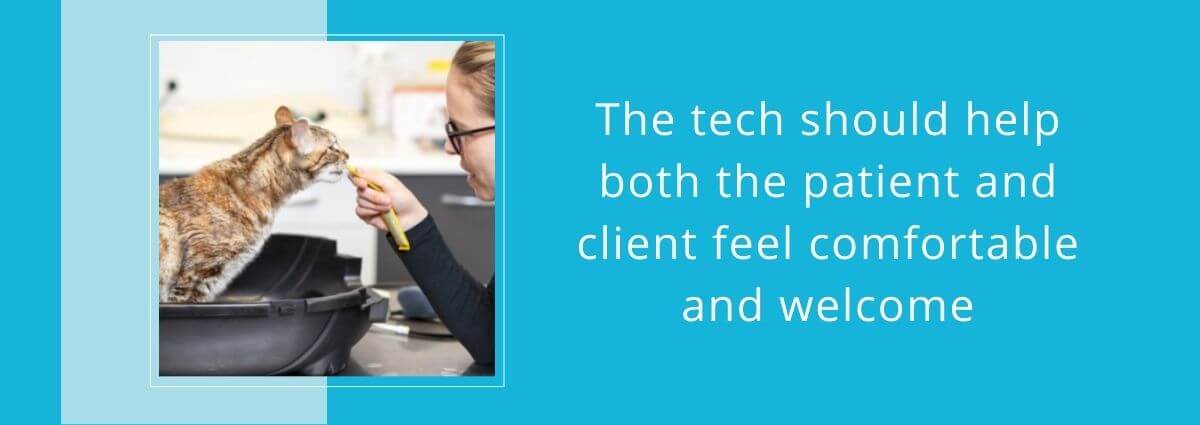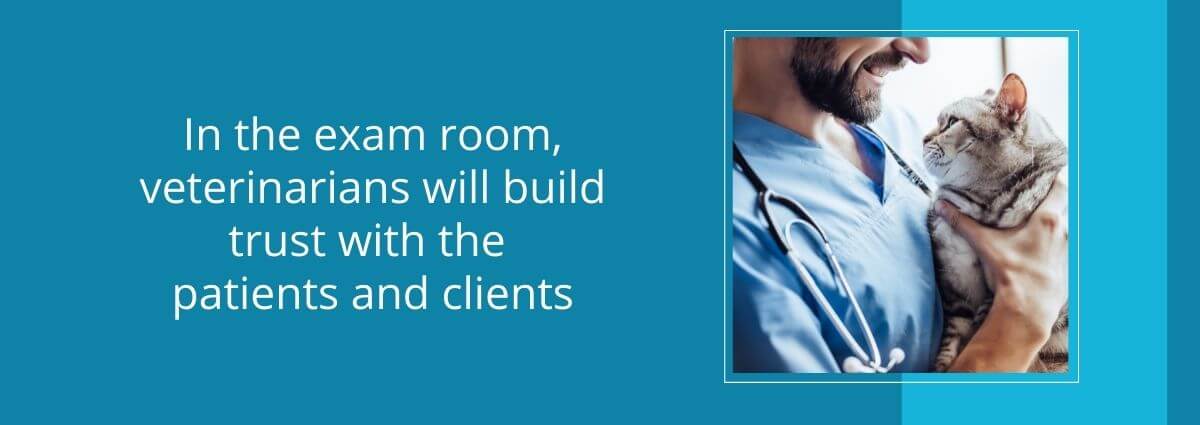Veterinary Exam Rooms: Teamwork Strategies For Bonding New Clients To Your Practice
Your veterinary team spends much of each working day in your practice’s exam rooms. But it’s helpful to remember that most of your clients are in those rooms for only about 30 minutes, maybe a handful of times per year. That means you have a limited amount of face-to-face time to create an experience that clients will remember as valuable, engaging, and beneficial. This article will look at the teamwork strategies that will make new clients feel welcome and keep your exam rooms filling with appointments.
Lay the Groundwork with Cleanliness and Culture
Obviously, running appointments on time will start the exam room experience on the right foot. And your exam rooms must be as clean and fresh-smelling as your front lobby. But beyond the physical setting, don’t forget how your culture is reflected here. When clients see your employees working well together, they’ll feel at ease. They’ll feel confident in the care you’ll provide because your team is competent, efficient, and friendly.
The rest of the first appointment depends on teamwork, and bonding through a lifetime of appointments depends on the impression your team leaves at this time. Each of your staff members plays a role in creating a successful new client appointment through exam room flow.

Try this: Reserve a cats-only exam room where feline patients can relax quietly, away from any excited dogs in the front lobby. Both pet and owner will appreciate this thoughtfulness!
The Receptionist’s Role in Exam Room Flow
After check-in, as the receptionist shows a new client and patient into an exam room, she should remember to put herself into that client’s shoes. This may not be their first-ever visit to any veterinarian, but it is their first visit to your practice, and they really don’t know what to expect. To set them at ease, the receptionist can explain, “I’m showing you into this exam room so that we can get you ready for Fluffy’s preventive care visit today.” Highlight the reason for the day’s visit to confirm the client’s expectations and motivations for scheduling the appointment.
Keep explaining the appointment flow: “The technician will come in next to get a little more information from you and review any medications Fluffy is currently on. You’ll be able to share any concerns or ask any questions that you may have, too.” The receptionist will then communicate to the appropriate technician to ensure that the next phase of the appointment stays on time. Your team must keep that communication going. If for some reason, you’re running behind, the receptionist must know this, and she must update the client with specifics about how long any delay will be. As long as you are honest, warm, and authentic, new clients will appreciate you, even with a minor delay.
Try this: Say, “The technician, Sue, will be in to see you in about 3 minutes. I know you’re here to have Buster’s rabies vaccine updated, but you had mentioned you were worried about his bad breath. Be sure to ask Sue how we can help you with both of those things today!”
Tactics for Technicians During Appointments
When the technician enters the exam room, she’ll introduce herself to the client and the pet to make them feel genuinely welcome. She’ll then reiterate the reason for the visit, demonstrating your team’s competence and communication. This is another opportunity to explain to the client what will happen: history-taking, medication review, vital sign assessment, etc. Again, clients don’t know exactly what will happen during each visit, so they don’t have a thorough understanding of what your staff is doing throughout an appointment. Don’t let them feel confused or shut out of their pet’s healthcare.

The technician should follow up with some open-ended questions. Basic history-taking can become cold and impersonal, and even at this time, you want first-time clients to feel a sense of warmth. When you ask questions that require more than a yes or no answer, you ensure that all of a pet owner’s concerns are being addressed. Don’t make the client feel rushed, and help them be well-educated.
Then, during the receptionist’s “hand-off,” the technician will let the client know when to expect the doctor to come in.
Try this: Say, “Thank you for letting us care for Buster today! I see some signs of dental disease, which explains your concerns about his breath. I’ll let Dr. Smith know, and she can help you explore some solutions in about 4 minutes when she comes in.”
Doctor’s Duties: Communication to Boost Compliance in the Exam Room
The veterinarian will provide just as warm a welcome to the pet and owner, and with a full briefing from the technician, she’ll be prepared to answer questions and address concerns. Again, when clients feel heard, they’re receptive to education and confident in your care. In this way, the exam room experience can nurture client compliance.

This is called an exam room because, obviously, this is where the doctor will perform the exam. However, this is also where clients learn -- not just about the best care they can provide their pets but also about the culture of your practice and the trustworthiness of your team.
Try this: “Mrs. Jones, I see the beginning stages of dental disease that Sue alerted me to. Let’s talk about brushing Buster’s teeth and using some dental chews so that you can take care of both his breath and his health.”
Bringing it all Together
As their time in the exam room wraps up, this new client and patient will see the culmination of communication and teamwork. The technician will bring medications into the room with clear explanations from the doctor. The receptionist will know when and why the next appointment should be scheduled from the tech. Forward booking will continue to bring clients back to your exam rooms repeatedly.
Try this: The receptionist should carefully explain the what's and the whys behind the doctor's recommendations for follow-up visits. For example, she might say, “Mrs. Jones, Dr. Smith needs to check on Buster’s teeth and gums in 6 months to help you manage his breath and see how well we’re able to keep his oral bacteria from affecting the rest of his health. Let’s look at an appointment during the second week of November. We’ll contact you with reminders to help you keep your schedule on track.”

First-time clients need to see your staff managing -- and exceeding -- expectations as a cohesive team. Because clients aren’t on site all day, in the treatment areas, or behind your front desk, they’ll get the best look at your team working in the exam room. Take this opportunity to connect with pet owners with your team’s best communication skills and warmth, and they’ll feel comfortable visiting your practice throughout their pets' lives. The exam room may be one of the smallest areas of your hospital, but it’s where you can make the biggest impression.
Are you maximizing your ability to bond with clients by meeting and exceeding their expectations in the exam room and beyond? Request a Veterinary Practice Marketing Health Exam for a thorough expert analysis of how you’re reaching local pet owners through your website, online reviews, social media, and search results!

